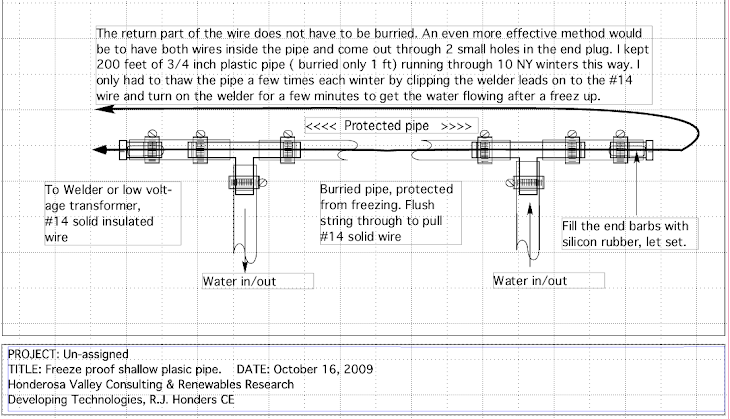
 The huge variation in stream flows during a season make exact measurements difficult and un-necessary. We experience 500 to 1 in a typical season, and I have seen 5000 X more water than typical low flows. An existing dam, batter board wier or even a place in the stream where all the water is flowing through a fairly constant depth channel or puddle will do to make observations and measurements that are detailed below. I think a computerized data logging setup is ideal but over kill. It is also likely to go down stream in the first big storm. And if you are lucky enough to experience a 100 year event you'll not only lose your equipment and maybe your dam, but you will see first hand what your intake structure has to be built to withstand! And yes, that wooden flume is temporary / test. It will be upgraded to stone (for aesthetics) and concrete for strength and durability. Look at the live webcam on the intake
The huge variation in stream flows during a season make exact measurements difficult and un-necessary. We experience 500 to 1 in a typical season, and I have seen 5000 X more water than typical low flows. An existing dam, batter board wier or even a place in the stream where all the water is flowing through a fairly constant depth channel or puddle will do to make observations and measurements that are detailed below. I think a computerized data logging setup is ideal but over kill. It is also likely to go down stream in the first big storm. And if you are lucky enough to experience a 100 year event you'll not only lose your equipment and maybe your dam, but you will see first hand what your intake structure has to be built to withstand! And yes, that wooden flume is temporary / test. It will be upgraded to stone (for aesthetics) and concrete for strength and durability. Look at the live webcam on the intakehttp://powershack.shacknet.nu:1026/
Why measure something that varies sooo much so exactly? Any experienced hydrologist or keen long time observer of a stream can tell you the 'design flow' to use for your micro hydro setup. A hydrologist or you could determine the watershed area by studying Google earth.
 The watershed area and the number and size of the lakes and reservoirs tells you a lot about your stream or river. Our watershed is only 1.5 square miles and contains only one 2 acre pond. Our rainfall data shows about 50 inches / year, another figure to add into your considerations. Then you should try to determine (by a few measurements throughout a year) 'Q95' , the Quantity of water flow that is exceeded 95% of the time. So only 5% of the time there is less water and you won't be able to run your system effectively and leave enough water for the fish.
The watershed area and the number and size of the lakes and reservoirs tells you a lot about your stream or river. Our watershed is only 1.5 square miles and contains only one 2 acre pond. Our rainfall data shows about 50 inches / year, another figure to add into your considerations. Then you should try to determine (by a few measurements throughout a year) 'Q95' , the Quantity of water flow that is exceeded 95% of the time. So only 5% of the time there is less water and you won't be able to run your system effectively and leave enough water for the fish.Another useful figure to estimate is 'Q50' , the quantity of water exceeded half the time throughout a year. This is the upper limit on your design flow and you will tend to spend more on bigger pipe and turbine, run for only half the year (on average) but produce the most KWhrs. This design flow should only be considered if you are grid connected and selling back. I selected Q75 (1800 Gal/min in our case) for our design flow because we run autonomous (totally off the grid) for 9 months when we have plenty of water to make about 20Kw 24/7, all of which we try to use up in 2 1/2 households.
We switch back to the local utility for a few months in the late summer when we don't use much electricity anyway, and don't have enough water to keep Q95 (150 Gal/min) flowing. My ultimate goal is to work out an arrangement with the utility company to become grid connected. Then we could 'store' the winter generated excess power in the grid and withdraw this 'stored' energy during late summer. Ideally the Utility would allow us to 'net meter' like they allow for wind, solar, and bio generated electricity. Net metering does not require any special equipment or meters, the energy flows both ways, and your existing meter runs forward and backward to keep track. But alas, the Utility in their infinite wisdom, excludes Micro Hydro from net metering. So we should all lobby to get net metering for all renewable energy. Even a cap, of say 25 KW, would be acceptable. Beyond 25 KW you could probably justify the expenses of special meters and switch gear. Now I'm Getting off topic.
Happy Hydro!
Rob


















